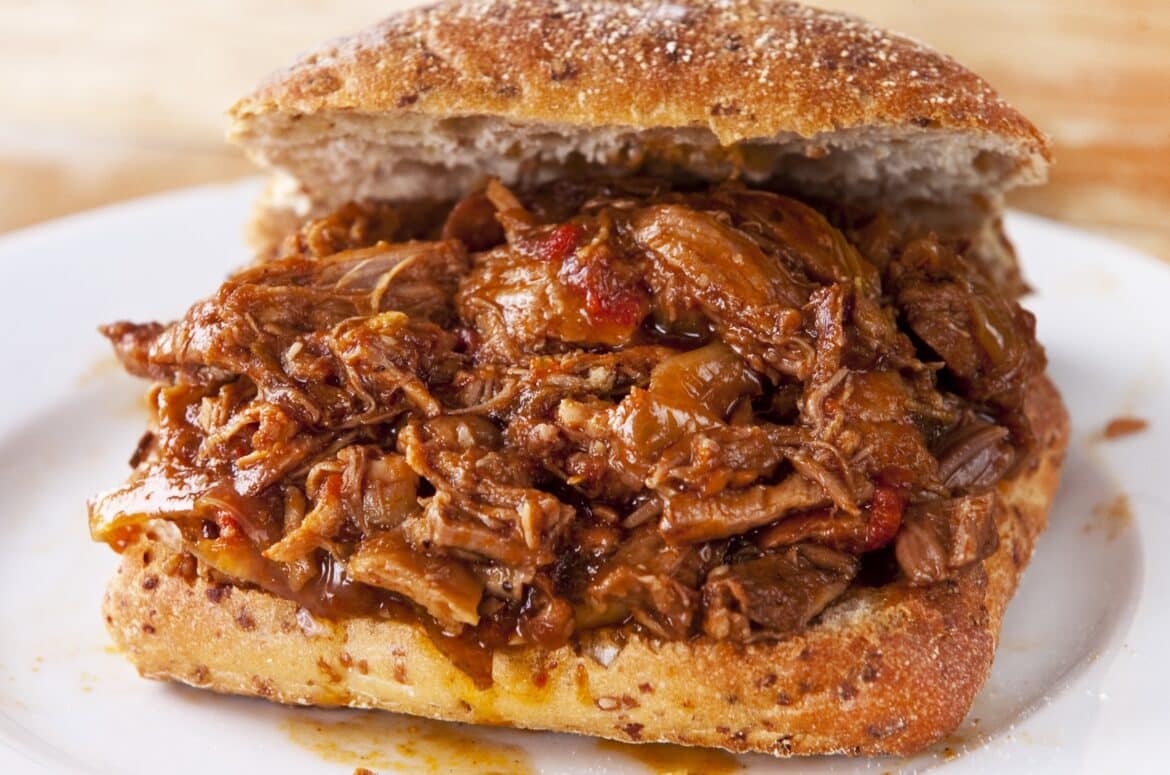Introduction
Is Pulled Pork Good For Weight Loss: Many people are often surprised to learn that certain indulgent-sounding dishes, such as pulled pork, can actually be incorporated into a weight loss plan when enjoyed in moderation and with mindful consideration. Pulled pork, a mouthwatering delight synonymous with Southern barbecue, may seem like an unlikely candidate for a weight loss-friendly menu, given its rich, smoky flavor and tender, juicy texture. However, beneath its flavorful façade lies a versatile protein source that, when prepared thoughtfully, can align with your weight loss goals.
Pulled pork is typically made from slow-cooked, seasoned pork shoulder or butt, and while it can be high in calories and saturated fats, its potential benefits for weight loss stem from both its preparation methods and nutritional composition. When prepared at home, you have control over the ingredients and cooking techniques, enabling you to make healthier choices. One significant advantage of pulled pork is its high protein content. Protein is a crucial nutrient for weight loss, as it helps control appetite, increase feelings of fullness, and maintain muscle mass while burning fat. Consuming lean cuts of pork and trimming excess fat can help you reduce calorie intake without sacrificing protein. Additionally, slow cooking methods can render the meat tender and juicy without adding excessive calories.
The versatility of pulled pork offers opportunities to incorporate it into balanced, weight-conscious meals. By pairing it with fiber-rich vegetables, whole grains, and appropriate portion sizes, you can create satisfying, nutrient-dense dishes that support your weight loss journey. It’s essential to be mindful of sauces and toppings often paired with pulled pork. Traditional barbecue sauces can be high in sugar and calories, so opt for lighter or homemade versions with reduced sugar content. Additionally, choose whole-grain buns or skip them altogether to save on unnecessary carbs and calories.

Is pulled pork good for a diet?
Pork is a rich source of certain vitamins and minerals your body needs to function, like iron and zinc. It’s also an excellent source of high-quality protein. Minimally processed, lean, fully-cooked pork eaten in moderation can provide certain benefits when added to your diet.
Protein: Pulled pork is a protein powerhouse. A 3.5-ounce (100-gram) serving can provide around 25 grams of protein. Protein is essential for muscle growth, repair, and overall body function.
Vitamins and Minerals: Pulled pork contains vitamins and minerals, such as B vitamins (B6, B12, niacin) and minerals like zinc, selenium, and phosphorus. These nutrients play key roles in energy metabolism, immune function, and bone health.
Fats: While pork does contain fat, a significant portion of it is the healthier monounsaturated and polyunsaturated fats. However, it’s essential to note that the cooking method and sauces used can affect the overall fat content.
Calories: Pulled pork is calorie-dense due to its protein and fat content. A moderate portion is advised to avoid excessive calorie intake.
Is pulled pork high in fat?
If fat is your concern, pulled chicken contains eight grams of fat and two grams of saturated fat for a three-ounce serving. Pulled pork has 13 grams of fat and four grams of saturated fat for the same serving size.
Marbling in the Meat: Pork shoulder and butt are well-marbled cuts of meat, meaning they have intramuscular fat. While this fat contributes to the tenderness and flavor of the dish, it also adds to the overall fat content.
Cooking Method: Traditional pulled pork is slow-cooked, often smoked, which allows some of the fat to render out of the meat. However, the cooking process may also involve basting with fatty sauces, which can increase the fat content.
Sauces and Rubs: The choice of sauces and rubs can significantly impact the fat content of pulled pork. Some barbecue sauces are high in sugar and fat, while others may be leaner.
Trimming: The fat on the surface of the meat can be trimmed before cooking, reducing the fat content of the final dish.
Is pulled pork high in calories?
Pulled pork provides a good source of energy, thanks to its calorie content. A 3-ounce serving of pulled pork typically contains around 250-300 calories, depending on the cooking method and seasonings used.
Type of Meat: The cut of meat used plays a significant role in determining the calorie content. Pork shoulder and pork butt are relatively fatty cuts, which can contribute to higher calorie levels compared to leaner cuts of pork.
Cooking Method: Traditional pulled pork is slow-cooked, often smoked, which can allow some of the fat to render out of the meat. However, the cooking process can also involve basting with high-calorie sauces or marinades, potentially increasing the calorie count.
Serving Size: The portion size of pulled pork consumed is crucial in determining calorie intake. Larger servings naturally contain more calories than smaller ones.
To give you an idea of the calorie content, a typical 3.5-ounce (100-gram) serving of pulled pork prepared from pork shoulder can contain approximately 250-300 calories. However, it’s essential to that serving sizes can vary, and additional ingredients like sauces or sides can contribute to the overall calorie count.
Is pulled pork healthier than a burger?
Although many people think that beef is healthier than pork, we must look at this conclusion from a few perspectives. When looking at the base nutrients such as protein and fats they are nearly identical. If we compare fatty cuts of pork and fatty cuts of beef, the pork has larger amounts of healthy fats.
Protein: Pulled pork is a good source of protein, with a 3.5-ounce (100-gram) serving providing approximately 25 grams of protein. Protein is essential for muscle maintenance and overall bodily functions.
Fats: Pork contains both saturated and unsaturated fats. While it offers a mix of these fats that the specific fat content can vary based on factors such as the cut of meat and cooking method.
Calories: Pulled pork can be calorie-dense due to its protein and fat content. A typical serving can range from 250 to 300 calories, but portion sizes can vary widely.
Vitamins and Minerals: Pulled pork provides essential nutrients like B vitamins (B6, B12, niacin), zinc, selenium, and phosphorus, which support various bodily functions.
Can you eat pulled pork everyday?
Nutritionally, pork possesses a wide range of essential nutrients like energizing B vitamins, choline for developing babies, and iron for healthy red blood cells. A 3-ounce serving of lean pork is loaded with protein and low in fat. Eating lean pork daily can be a part of a well-balanced, high-nutrient diet.
Calorie Density: Pulled pork can be calorie-dense due to its combination of protein and fat. Consuming it in excessive amounts may lead to overconsumption of calories, potentially contributing to weight gain.
Saturated Fat Content: Pork, especially fattier cuts like pork shoulder or pork butt, can be high in saturated fat. Excessive saturated fat intake is associated with an increased risk of heart disease. It’s balance your fat intake and choose leaner cuts when possible.
Sodium Levels: Some preparations of pulled pork, particularly when marinated or seasoned with high-sodium ingredients, can contribute to increased sodium intake. High sodium intake may lead to high blood pressure and other health issues, so it’s to be mindful of your salt consumption.
Digestive Health: Consuming pulled pork every day may lead to digestive discomfort for some individuals. It’s a rich and heavy dish that can be harder to digest, potentially causing digestive issues like bloating or indigestion.
Is pulled pork or beef better?
In terms of taste, both meats are tasty and succulent. For most people, brisket tastes better than pulled pork. However, it must be said that some people find pulled pork to be tastier.
Protein: Both pulled pork and pulled beef are excellent sources of protein, which is essential for muscle growth, tissue repair, and overall health. A 3.5-ounce (100-gram) serving of each typically provides around 25 grams of protein.
Fat Content: The fat content can vary depending on the cut of meat and preparation method. Pulled pork, especially if made from fattier cuts like pork shoulder, can contain more saturated fat. On the other hand, pulled beef, made from leaner cuts, may have less saturated fat.
Calories: The calorie content of pulled pork and pulled beef is similar, with both providing around 250-300 calories per 3.5-ounce serving. The calorie count can be influenced by factors such as the cut of meat, cooking method, and any added ingredients like sauces.
Vitamins and Minerals: Both meats offer essential nutrients like B vitamins (B6, B12, niacin), zinc, selenium, and phosphorus. These nutrients play crucial roles in various bodily functions.
Is pulled pork processed meat?
Processed meats are any meats that aren’t fresh. People typically think of processed meat as only referring to pork and beef, but this category can also include poultry (chicken, turkey, duck) and fish.
Is Pulled Pork Processed Meat
Pulled pork, in its simplest form, is typically not considered processed meat. It starts as a whole cut of meat, such as pork shoulder or pork butt, and undergoes a cooking process that includes slow-roasting, smoking, or braising until it becomes tender enough to be easily shredded. The seasoning used may include salt, spices, and herbs, but it generally doesn’t involve the extensive processing methods seen in other processed meats.
However, it’s essential to recognize that the line between processed and unprocessed meat can blur in some cases. Some variations of pulled pork may involve pre-packaged seasonings or commercially prepared sauces, which might contain additives or preservatives. These additions can potentially push it into the processed meat category. It’s crucial to read ingredient labels and be aware of how the pulled pork is prepared to determine whether it falls into the processed category.
Health Considerations
Sodium Content: Processed meats often contain higher levels of sodium due to the use of salt in their preparation. Excessive sodium intake can contribute to high blood pressure and cardiovascular issues.
Additives: Processed meats may contain additives such as nitrates and nitrites, which are used for preservation and flavor enhancement. While these compounds are considered safe in moderation, their consumption in excess has raised health concerns.
Saturated Fat: Some processed meats, like sausages and bacon, can be high in saturated fat, which, when consumed in large amounts, is linked to heart health issues.
Cancer Risk: The International Agency for Research on Cancer (IARC) has classified processed meats as Group 1 carcinogens, meaning there is sufficient evidence to suggest that their consumption is linked to an increased risk of certain types of cancer, particularly colorectal cancer.
Is pulled pork easy to digest?
Quick Summary. Chicken, fish, and shellfish are typically easier to digest due to their low fat and fiber content, while pork and beef are more difficult due to their higher fat content. The digestion of meat varies based on its fiber and fat content, with leaner cuts being easier to digest than fatty ones.
Choose Leaner Cuts: Opt for leaner cuts of pork, such as loin or tenderloin, when preparing pulled pork. These cuts have less fat and connective tissue, which can reduce the likelihood of digestive discomfort.
Trim Excess Fat: Before cooking, trim excess fat from the meat to reduce the overall fat content.
Use Mild Seasonings: If you have a sensitive stomach, consider using milder spices and seasonings in your pulled pork recipe. This can help reduce the risk of irritation.
Limit Sauces: Be mindful of the sauces and condiments you add to your pulled pork. Choose options with simple ingredients and lower sugar content to minimize potential digestive issues.
Control Portion Size: Pay attention to portion sizes. Start with a moderate serving and see how your digestive system responds before eating more.
Include Digestive-Friendly Sides: Pair your pulled pork with digestive-friendly side dishes like steamed vegetables or a small serving of rice or potatoes to balance your meal.

Conclusion
Pulled pork’s potential benefits for weight loss come from its high protein content, which aids in appetite control and muscle preservation during weight loss. The key is to choose lean cuts of pork, trim excess fat, and prepare it using healthier cooking methods such as slow cooking. This ensures that you get the protein without an overload of calories. The versatility of pulled pork allows for creative and nutritious meal preparations. By pairing it with vegetables and whole grains, you can create satisfying and fiber-rich dishes that promote satiety and provide essential nutrients.
However, it’s crucial to exercise caution with the accompaniments. Traditional barbecue sauces, high in sugars and calories, should be used sparingly or substituted with healthier alternatives. The choice of buns or bread can also impact the overall calorie count of your pulled pork dish, so consider whole-grain or low-carb options to keep your meal balanced. Weight loss is not solely determined by individual foods but by the overall composition of your diet and lifestyle. Pulled pork can certainly be part of a successful weight loss plan when integrated thoughtfully alongside other nutritious foods and physical activity.
Moderation and portion control are key factors in incorporating pulled pork into a weight loss strategy. Monitoring your calorie intake and balancing your macronutrients will help you achieve your goals while enjoying the indulgent flavors of this Southern classic. It’s also essential to tailor your approach to your unique dietary preferences and nutritional needs.

